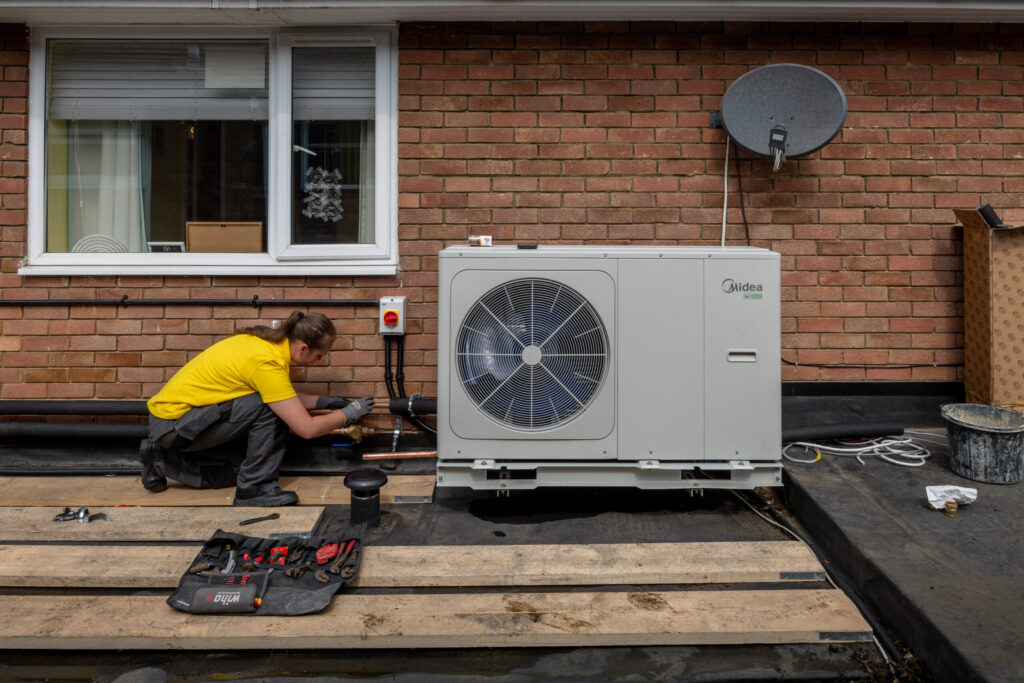If you’re looking for an efficient, eco-friendly way to heat your home, you’ve probably heard about air source heat pumps (ASHPs). These systems are becoming increasingly popular in the UK thanks to government incentives, like the ECO4 scheme and the Boiler Upgrade Scheme, which help households transition to greener energy solutions.
But here’s the thing: not all air source heat pumps are the same. There are different types, each with its own features, benefits, and ideal use cases. Choosing the right one can make a big difference in your home’s comfort, energy bills, and long-term savings.
In this guide, we’ll break down:
- What air source heat pumps are and how they work
- The main types of air source heat pumps
- Advantages and disadvantages of each type
- Which one might be right for your home
- Costs, efficiency, and government funding options
What is an Air Source Heat Pump?
An air source heat pump is a renewable heating system that extracts heat from the outside air and transfers it indoors to heat your home or water. Even in cold weather, there’s still heat in the air that can be captured and used.
How They Work:
- The outdoor unit absorbs heat from the air into a refrigerant.
- The refrigerant is compressed, increasing its temperature.
- The heat is transferred to your home’s heating system (radiators, underfloor heating, or hot water cylinder).
Think of it as a reverse fridge — instead of removing heat from food, it pulls heat from outside and moves it indoors.
The Two Main Types of Air Source Heat Pumps
There are two primary types of ASHPs:
1. Air-to-Air Heat Pumps
- What They Do: Transfer heat from outside air directly into warm air indoors.
- How They Deliver Heat: Through fans or ducts, similar to an air conditioning system (but reversed).
- Best For: Homes without central heating systems or properties that want both heating and cooling.
Pros:
✅ Can provide both heating and cooling
✅ Lower installation cost compared to air-to-water systems
✅ No need for radiators or underfloor heating
Cons:
❌ Cannot produce domestic hot water
❌ Requires ducting or indoor air units
2. Air-to-Water Heat Pumps
- What They Do: Transfer heat from outside air into water, which is then circulated through radiators, underfloor heating, or stored in a hot water cylinder.
- Best For: Homes with existing central heating systems or new builds looking for a complete heating and hot water solution.
Pros:
✅ Can provide heating and hot water
✅ Works well with underfloor heating for maximum efficiency
✅ Compatible with traditional radiators (with adjustments)
Cons:
❌ Higher upfront cost than air-to-air systems
❌ Works best with low-temperature heating systems
Sub-Types of Air-to-Water Heat Pumps
Within the air-to-water category, there are more specific types to consider:
Monobloc Systems
- All components are contained in a single outdoor unit.
- Easier and quicker to install.
Best For: Smaller homes or those with limited indoor space.
Split Systems
- Components are divided between an outdoor unit and an indoor unit.
- More flexible installation and often higher efficiency.
Best For: Homes needing a more powerful or adaptable system.
Efficiency Considerations
When comparing types, it’s important to look at COP (Coefficient of Performance) — the ratio of heat output to electricity input.
- Typical COP for modern ASHPs: 3 to 4 (meaning 1 unit of electricity can produce 3–4 units of heat).
Which Type is Right for You?
- Small homes or flats: Air-to-air or compact monobloc air-to-water
- Family homes with central heating: Air-to-water split system
- Homes in colder regions: High-performance split system with backup heating
Costs & Funding Options
Typical Costs in the UK:
- Air-to-Air: £3,000 – £6,000
- Air-to-Water: £7,000 – £14,000
Funding Options:
- ECO4 Scheme – Free installation for eligible low-income households
- Boiler Upgrade Scheme – £7,500 grant towards installation
- Local council grants and green energy incentives
Advantages of Air Source Heat Pumps
- Lower energy bills compared to electric or oil heating
- Reduced carbon footprint
- Long lifespan (up to 20 years with maintenance)
- Low maintenance needs
Disadvantages to Consider
- Higher upfront cost compared to traditional boilers
- Reduced efficiency in extremely cold weather (but still works)
- May require insulation upgrades for maximum efficiency
Final Thoughts
Choosing the right type of air source heat pump depends on your home’s heating needs, existing infrastructure, and budget. If you want a complete heating and hot water solution, air-to-water systems are the way to go. For simple space heating and cooling, air-to-air systems are more cost-effective.
